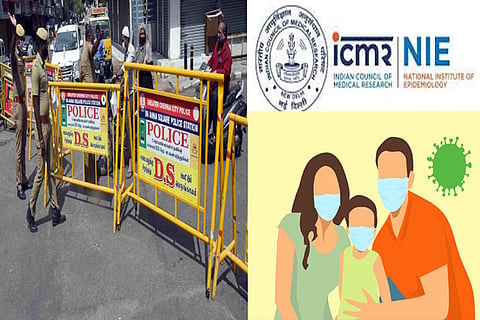

Vellore
Though it reported the first COVID-19 case in the country, Kerala managed to quickly keep the number of cases down. At the international level, several Southeast Asian countries brought down the cases in comparatively lesser number of days than Tamil Nadu.
Experts said those countries had earlier dealt with SARS outbreak, which helped them manage the situation better. “They could recover better because of having experienced a similar outbreak earlier. Many countries have pandemic preparedness programmes,” pointed out Dr Prabhdeep Kaur, deputy director, National Institute of Epidemiology (ICMR).
She added that the public health interventions in Tamil Nadu could not keep pace with the transmission of the virus. One miscalculation was looking at international models without factoring in local scenario. “Lockdown could bring better results in several countries that Tamil Nadu, because our settings include 30 lakh people in slums and crowded markets. The approach on lockdown could have been different keeping in mind the local situation,” she noted.
According to her, lack of cooperation from the public was another factor. “Seventy per cent compliance to masking would yield similar results as that of lockdown. Though lockdown helped the health systems to prepare for spike in cases, people still do not use masks properly. Opening public transport in several districts was another wrong move or it needed better planning,” Dr Kaur added.
Agreeing with her on the importance of masks, noted virologist opined that wearing masks was the more effective alternative to the “draconian lockdown”. He cited a paper published in the US two days ago that revealed how the spread of the pandemic was much less in states which followed mask wearing compared to the states that failed to do so.
“Government complacency was based on the idea that the virus would disappear in 21 days. Even PM Narendra Modi stated so. But it failed to use first 21 days to meticulously plan for the future regarding availability of health infrastructure and trained doctors. We are now reaping the result of that lack of action,” he said.
However, Dr Anantharam Raghavendran from virology department of Vellore’s New Naruvi hospital said if not for the lockdown, the pandemic would have peaked much earlier, putting strain on the health infrastructure. Another reason that several public health workers raised was the lack of coordination among several arms of the government like Local Administration, Health department, Greater Chennai Corporation and Disaster Management.
Long curfew helped TN docs to prepare better for COVID battle
From March 25, when the lockdown was imposed, the State only had 15 COVID cases. Today, on July 2, after 100 days of lockdown, health officials have come a long way in fighting the pandemic even as the cases continue to pile. Though the numbers are high- with the tally crossing 90,000 - officials express confidence about having gained more insight into the disease and know how to manage it better.
While fever, breathlessness and dry cough were the only recognised symptoms earlier, doctors now associate loss of smell, taste, general weakness, fatigue and even abdominal pain as warning signs.
Officials from the Directorate of Public Health and Preventive Medicine said that various co-morbidities that would make a person vulnerable are also clearer now. As a result, cocooning and monitoring of such people is being better planned and this has also led to an evolving strategy. Though the basic protocol on quarantine, isolation and other preventive measures remain the same, treatment strategies have greatly improved. The time period of quarantine has also come down from 28 to a maximum of 10-14 days and there is no discharge test needed anymore. Also, use of steroids, injections and other drugs has been well established over a period of time.
“Heparin can be used as an anticoagulant drug to save critical patients. Steroids can be life-saving drugs; anti-viral drugs including Remdesivir, Tocilizumab, and Enoxaparin can also be used. The effect of these drugs on patients has been understood over the past three months. Case by case review also helped in coming up with better treatment standards and the use of Ayurveda and Siddha medicines to build immunity has also proved beneficial,” said public health expert and former public health director Dr K Kolandaisamy, who had been spearheading the public healthcare system until his retirement recently. “Though we stressed on strict lockdown earlier, the effectiveness could not be established. We now know that only vulnerable people need to stay indoors and controlled lockdown can be implemented,” he added.
Health officials also said that the spike in cases led to strengthening of the public health sector, including infrastructure and capacity at government and private hospitals. “Despite having one of the best health sectors pan India, we had to ramp it up completely. Besides, ensuring adequate testing was also a major task. We realised micro level plans are needed. Earlier, we did not have local influencers but now many NGOs help COVID management in slums,” said Health Secretary J Radhakrishnan.
He pointed out that standard protocols were not available then and doctors and researchers had to analyse ICMR and international recommendations for solutions. “We now have plasma therapy trials. Besides we are continuing with add-on therapies and studies on effects of Indian medicines. At present, we have 11 standard protocols, especially for those with co-morbidities,” said Radhakrishnan.
As more than 50,000 people have recovered, doctors have realised that early treatment can help reduce mortality rate. “COVID-19 being a new strain, people are not yet immune to it. Besides, there is no 100% compliance to masks, social distancing and hand washing as people are generally negligent till they are affected,” Radhakrishnan added.
(With inputs from Tharian Mathew)
Visit news.dtnext.in to explore our interactive epaper!
Download the DT Next app for more exciting features!
Click here for iOS
Click here for Android